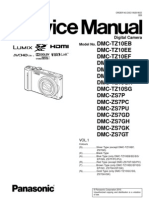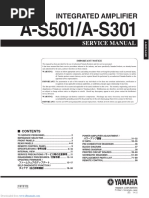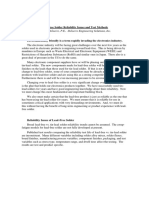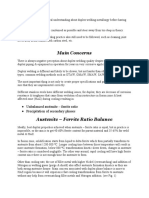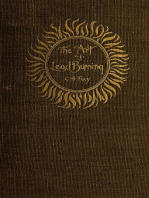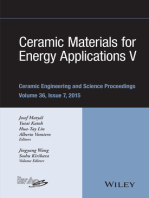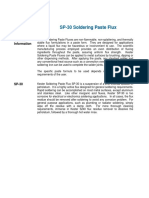Wave Soldering of High Complexity PWB's FINAL
Wave Soldering of High Complexity PWB's FINAL
Uploaded by
rajppdCopyright:
Available Formats
Wave Soldering of High Complexity PWB's FINAL
Wave Soldering of High Complexity PWB's FINAL
Uploaded by
rajppdCopyright
Available Formats
Share this document
Did you find this document useful?
Is this content inappropriate?
Copyright:
Available Formats
Wave Soldering of High Complexity PWB's FINAL
Wave Soldering of High Complexity PWB's FINAL
Uploaded by
rajppdCopyright:
Available Formats
Lead-Free Wave Soldering of High Complexity PWBs The transition to lead-free wave soldering has brought with it many
challenges. As with any new manufacturing technology entering a production environment, many of the associated challenges are anticipated and prepared for in advance, but other challenges cannot be addressed until production volumes are high enough to flush out all the issues and provide data and insight to their resolution. So the engineering community learns as production ramps up. Lead-free wave soldering has been around for many years. Long before the RoHS legislation, electronics assemblies that experience high service temperatures used tinsilver solder because of its higher melting point. These assemblies were designed for harsh environments and were not very complex; yields were acceptable. When RoHS requirements came to the mainstream of assembly, the first products to transition were also comparatively simple: consumer electronics, single- or double-sided, with relatively trouble-free SMT devices if any - on the solder side of the PWB. Transition of the assemblies was straight forward, as the process settings did not significantly differ from the tin-lead parameters, and often the original tin-lead capable flux could be used successfully in the lead-free process. Weve learned over the last several years that the typical 0.062 (1.6mm) PWBs will experience a somewhat tighter process window when going lead-free. The preheat requirements do not change very much, and most of the existing soldering systems are fully capable. The solder temperature can increase by up to 25o F (see sidebar), depending on the melt temperature used in tin-lead process (I can recall years of wave soldering with the tin-lead pot set at 500 F). Hole fill can sometimes be more challenging, especially with some OSP finishes. Dwell time on the wave may be a second or two higher. The drainage or debridging properties of lead-free solder is not quite as good as tin-lead, so finer pitch parts may present issues. All in all, most of the challenges seen on less complex assemblies have been easily addressed by developing the right parameter settings and using basic process control measures. As thicker, higher-layer count, more complex assemblies (think telecom infrastructure) make the transition, the difference between the tin-lead and lead-free processes grows. This is one of those areas where the engineering community can predict the issues, but cannot study and address them until higher production volumes supply the necessary information. Now that some higher complexity assemblies are being produced in larger volumes, the challenges are becoming clear: The hole fill challenge seems to increase exponentially as board thickness increases. Higher layer counts and numerous ground connections exacerbate the hole fill issues. The higher thermal mass associated with the additional signal and ground layers creates preheat challenges. If selective solder pallets are used, they shield areas of the PWB from preheat exposure, exacerbating the preheat problems.
On simpler assemblies, a robust lead-free soldering process could be dialed-in by tweaking the existing tin-lead process. Basic DOEs or even trial-and-error methods would suffice at developing a high-yielding operation. This is not necessarily the case with higher complexity PWBs. To develop a robust process for more complicated boards, we need to gain a better understanding of the differences between individual factors in the processes. Figure 1 present an overview of these challenges:
Figure 1. Assemblers Challenges with Lead-Free Wave Soldering. In figure 1, the blue, downward pointing arrows itemize issues presented by individual aspects of the lead-free process. The yellow, upward facing arrows depict the improvements that are emerging in the market to address these new challenges and minimize their effects on yields and productivity. Decreased Wetting Speed Alloy wetting speeds vary among different alloys, fluxes, and melt temperatures.1 Although wetting balance test results do not predict wave solder performance, they do provide relative comparisons that demonstrate the effects of alloy composition, flux and temperature. More information on wetting speeds can be found at: (CA published an article by Anna Lifton in July, 2005 issue) The slower wetting speed translates to more skips on SMT devices and slower movement up the pins and barrels of PTH components. To overcome the slower wetting, longer
contact times on the wave or higher melt temperatures are needed. The latter may not be feasible due to its possible detrimental effects on the components or PWB. Decreased Fluidity Lead-free alloys exhibit less fluidity than tin-lead ones. These solders take longer to wet up the pins and barrels, and are more prone to shadowing effects on components with improper orientations or spacing that is too narrow. Just like the effects of decreased wetting speed, the issues of decreased fluidity need to be addressed with longer wave contact times. Decreased fluidity also translates to more solder bridges, as drainage upon peel-off from the wave is slower. Lead-free wave alloys are processed at temperatures much closer to their solidification point than tin-lead (about 70 deg F in lead-free versus 120 deg F in tin-lead), so the solder joints and bridges freeze faster. The faster solidification inhibits the use of debridging knives and makes the process even less forgiving, especially where poor design practices are involved. With slower drainage, faster solidification, and the absence of debridging tools, solder bridges must be addressed by concentrating on the peel-off area of the wave. Peel-off dynamics are affected by the speed of the conveyor, the height of the wave, and the speed of the waves pump. These parameters may require some fine tuning to effectively debridge finer pitch connectors or quad flat packs. Degradation of Solderable Surfaces Oxide formation is a function of time and temperature exposure of the solderable surfaces. Here weve got a classic example of the ongoing battle of good vs. evil: while the flux is trying to remove the oxides, more are forming. The higher preheat temperatures and longer times in the preheat tunnel increase the oxide formation on the leads, terminations, and PWB, actively working against the flux that is trying to clean them. Oxides are barriers to wetting, causing lower hole fill and more skips. Again, longer contact times are needed to overcome these obstacles. Processing Parameters Increased preheat temperatures, preheat times, alloy temperatures and contact times all put new demands on fluxes. They must be capable of sustaining the harsher thermal excursions throughout the entire process. No-clean fluxes are formulated to activate and fully de-activate for reliabilitys sake in typical wave process windows. A flux can be designed for the long, hot thermal excursions associated with high complexity assemblies, but it may not become properly deactivated in shorter, cooler ones on simpler assemblies that run processes times and temperatures similar to those used in tin-lead soldering. The need for a flux to provide good soldering and remain reliable in this broader thermal range puts new demands on the flux formulators by widening their target operating window while simultaneously limiting their options for activators and other ingredients. Compounding the Individual Effects
Slower wetting speeds, lower fluidity, more oxides, and more aggressive thermal exposures all combine to make lead-free soldering more difficult. As the PWB gets thicker and more complex, the effects of these issues grow larger and interact even more. Fortunately, solutions are continually being developed and introduced. Researchers around the world are studying new flux and alloy compositions to address the materials portions of the equation. Equipment suppliers are developing modifications to the mechanics of the process to help overcome some of the challenges introduced by the transition. And everyone is gaining process knowledge on an almost daily basis. Many methods exist to address the known issues in wave soldering complex PCBs. Some of them tackle root causes, and others are more like work arounds. In either case, they improve yields and limit rework. And certainly, as assemblers, equipment providers and materials suppliers quantify and understand the problems, more solutions will continue to emerge. Increasing Contact Time While increasing the contact time addresses wetting speed, oxidation and fluidity differentials to help improve hole fill and decrease skips, this practice has its down sides. Longer contact times heighten concerns of topside secondary reflow and copper dissolution. Additionally, slowing the conveyor enough to get adequate contact time may cause flux burnout in the preheat step of the process. Nozzle designs to accommodate lead-free processes typically locate the turbulent and smooth waves closer together, have wider contact lengths, and programmable wave pumps that increase the speed (and therefore the contact) once the boards has reached the wave and the danger of flooding it has passed. If lead-free soldering must be achieved with a tin-lead type nozzle configuration, the use of solder pallets may help. Pallets, due to their typical thickness and the location of stiffeners across the front, can run deeper immersion depths (and therefore longer contact lengths) without concerns of flooding the topside of the PWB. Turning up the wave height may help improve hole fill, but it may also hamper debridging efforts. Recall that the peel-off is far more critical to debridging in lead-free soldering than it is in tin-lead. Increasing the pump speed or wave height changes the shape and flow dynamics of the peel-off. Hole fill and debridging may need to be considered in a trade-off. If the trade-off is necessary, keep in mind that even the most stringent IPC workmanship standard, Class III, calls for minimum 75% hole fill. Topside solder fillets on through hole components could soon become considered a luxury of the bygone tin-lead era. Preheat Considerations Boards 0.093 (2.4mm) and thicker must use topside preheat. On simpler boards, it is still possible to have robust lead-free wave processes without topside preheat. This is not the case with thicker PWBs. To assure fully activated flux, the solderable surfaces (including the topside annular rings) must reach a minimum of 212o F. If only
bottomside preheaters are used, an enormous amount of heat energy must be directed through the flux on the bottom of the board and can de-activate it before the PWB reaches the wave. Topside preheaters help deliver heat from the opposite side of the PWB, providing the necessary heat energy without directly affecting the flux. When using topside preheaters, it is not uncommon to measure 285 o F (140o C) topside temperatures in order to achieve core temperatures greater than 212 o F. The newer, convection-style topside preheaters are far more efficient at transferring heat than the traditional infra red (IR) style. Preheat temperature has always been a primary factor in wave soldering. Preheat time has not historically been a serious consideration, but when soldering complex boards in a lead-free process, it is very important. Slowing the conveyor enough to achieve the higher contact times needed to fill holes on thick boards can double the residence time in the preheat tunnel. The actual thermal profile should be considered. This means using thermocouples and dataloggers to measure temperatures, not shortcutting the measurement process with temperature sensitive stickers or handheld pyromters. In the past, as long as topside or core temperature requirements were met, it didnt really matter what the profile looked like. But with preheat times (a.k.a. tunnel times) up to twice as long as tin-lead recipes, the impact on no-clean flux activity must be considered. A common bottomside heater configuration is IR-Convection-Convection. One of the big advantages of the IR zone is its ability to allow the flux carrier to spread and dry slowly before the board reaches the convections zones, which can blow wet flux carriers off specific areas of the assembly. Historically, the IR panels have been run rather hot, delivering lots of heat early in the preheat cycle. The subsequent convection modules could run a little cooler (although the temperature settings are not readily correlated) and soak the heat into the PWBs. In the case of long tunnel times, the assembler may reconsider the profile strategy, and turn the IR temperatures down, allowing the convection modules to provide the majority of the heat. Although two zones of preheat may appear to provide even less heating capability than a three-zone tin-lead process on what may already be a thermally challenging board, this is not necessarily be the case. Consider the following example: Assume a typical smooth wave contact length of 2.5 inches. Conveyor speed in tin-lead process of 5 ft/min (1 inch/sec) Provides typical 2.5 seconds contact time on smooth wave Machine has 6 feet of preheat (72 inches) o 72 seconds in preheat tunnel When contact time of 5 seconds is needed to get good hole fill with same nozzle, Conveyor speed is slowed to 2.5 ft/min (0.5 inch/sec) Machine still has 6 feet of preheat (144 inches) o Tunnel time becomes 144 seconds
To make the calculation easy, completely disregard the presence of the first preheater, although it is probably is on and running a cooler setting. This leaves only 4 feet (48 inches) of heated tunnel. o Tunnel time is 96 seconds Recall that it is strongly suggested that topside preheaters are used on thicker PWBs. In addition to having 96 seconds of bottomside preheat with this method (as opposed to the 72 seconds of the tin-lead process) the topside heaters are also delivering thermal energy to the assembly for a longer period than they were with the tin-lead recipe due to the slower conveyor speed. Topside Reflow Longer contact times at higher melt temperatures pose a greater risk of topside secondary reflow. Although the higher thermal masses of the thicker PWBs do absorb more heat, secondary reflow typically occurs on pads that are located near vias. When the hot solder fills the via, the heat travels through the trace to the pad and reflows the base of the existing solder joint. QFP and BGA lands located near vias are at the highest risk. Most design rules for distance from via to pad were based on tin-lead processing. Even though an assembly may have been properly designed for tin-lead processing, it may be more vulnerable in the lead-free process. When profiling complex PWBs, it is wise to locate a thermocouple on pad that is near a via which has proper thermal relief and preferably does not tie into any heat-sinking power or ground planes. Copper Dissolution Rapid dissolution of copper into tin-rich alloys has implications for both the solder pot and the PWB. As copper levels rise in the solder pot, the liquidus temperature of the melt rises and fluidity decreases even further. As copper is washed off the PWB, traces and annular rings become thinner or nonexistent. Pot contamination can be addressed through simple process control. The pot is initially charged with the alloy of choice (SAC305, -405, or -X0307 for example). It is recommended that initially solder samples be analyzed every 8000 PWBs. When copper levels rise, the pot is replenished with copper-free alloy (SAC300, -400, or -X0300). In the simplest of control methods, the pot is sampled and replenished with copper-bearing or copper-free alloy based on its measured composition. In more sophisticated control schemes, the sampling rates are adjusted based on historical performance and the replenishment alloys can be predicted based on both historical performance and anticipated production loading. With respect to solder joint integrity, copper dissolution can be addressed though design practices. One of the most vulnerable locations on the PWB to be affected by copper dissolution is the trace that connects to the annular ring. It is typically about 6 mils wide, and a portion of it is exposed by the relief of the solder mask. To avoid dissolving this thin segment of copper, solder mask defined pads can be used. Alternatively, if metal defined pads are used, the traces should be made wider where the solder mask relief
exposes them. Figure 2 shows a metal defined pad with wide traces that neck down underneath the solder mask.
Figure 2. The small amount of a traditional 6 mil trace where it is exposed by solder mask relief. Solder mask defined pads have presented reliability concerns in SMT devices, so naturally the question has arisen with respect to PTH devices. Although no reliability data is available on this design practice, it is becoming more widespread, and consultations with reliability experts indicate that there is no basis for serious concern. It should be noted that although the wider traces offer some protection against copper erosion of the exposed portion of the trace, the knee the area where the annular ring meets the barrel is typically a bit thinner than the barrel or the ring, and can be very vulnerable to erosion. As of yet, no design or fabrication guidance exists to address copper erosion of the knees. Facts and Fiction about Copper Dissolution There is a common myth that avoiding the use of OSP surface finishes will limit the amount of copper dissolved into the solder pot. Discussions with metallurgists indicate that only Electroless Nickel-Immersion Gold finishes can limit copper dissolution rates due to the nickel barrier layer. Hot Air Solder Level, Immersion Silver, Immersion Tin, and OSP are all believed to behave similarly with respect to copper dissolution.
Alloys with higher silver contents like SAC305 and SAC405 are believed to dissolve copper faster than lower silver content alloys, and experimental data is available to support this statement. Continued experiments are currently underway to quantify the effects of surface finish, alloy type, melt temperature, and dwell time on PWBs with both thin and thick traces exposed by solder mask relief. By the time this article goes to press, results of some of these experiments will have been published at the SMTA International conference. Blow Holes and Voids
Figure 3. Blow holes produced in lead-free soldering Figure 3 depicts a severe condition of blow holes.2 In tin-lead processes, blow holes are usually formed by the outgassing of moisture in the PWB laminate through breaches or thin spots in the barrel plating, and they look like small pinholes or small volcano peaks. It is believed that they are formed by the same outgassing mechanism in lead-free processing, but the blow holes can often look more like balloons when the solder solidifies quickly during the outgassing process. The blow hole phenomena is far more prevalent in lead-free processing than in tin-lead. The melt temperatures are higher and the contact times are longer, exposing the PWBs to a greater thermal spike at wave contact, which creates more volatiltization and higher internal pressures.
Figure 4. Cross section of soldered PWB that exhibited extensive voiding and blow holing. Notice the repetitive pattern of notches in the barrel wall.
Figure 5. Higher magnification cross section of barrel wall. This is from a different PWB than figure 4, but both were from the same lot that exhibited voiding and blowholing problems. Notice how thin the plating is in the notch. There are many unanswered questions about blow holing in lead-free soldering, and a root cause can not be absolutely, positively assigned at this time, but several investigations have led to the drilling process in fabrication as a major, assignable factor. Figure 4 shows a cross section of the boards that produced the blow holes shown in the previous picture. The repetitive uneven pattern on the barrel wall may indicate that it was not drilled smoothly, and the plating process could not properly cover the uneven areas. A higher magnification of the uneven area is shown in fig 5. The longer, hotter lead-free process is far less forgiving to plating imperfections than its faster, cooler tin-lead predecessor. Barrel wall strength that is sufficient in tin-lead processing may not be sufficient in leadfree processing. This is evidenced by the fact that, in some cases, the same lot of PWBs form blow holes in the lead-free process, but perform to expectation in the tin-lead process. Multiple cases of this occurrence have been witnessed and reported. Failure analysis experts with over 20 years experience in the field report that nearly all cases of blow holes they have diagnosed are due to the poor PTH construction. Assemblers should consult with their fabricators regarding board specifications for the higher complexity assemblies that will experience the more demanding soldering processes. Summary The top concerns when transitioning high complexity assemblies to lead-free wave solder processing include: Hole fill Tunnel time Topside reflow Copper dissolution Blow holes and voids There are no ideal solutions to address all the issues currently known, but understanding some of the mechanisms that affect these issues can help to limit their impact on yields and productivity. If trade-offs must be made, it is far better to make informed decisions rather than uninformed ones. Moving Forward For years we have continuously been hearing and reading that design for manufacture (DFM), process characterization, and process control are the fundamental elements of high yields and productivity in circuit assembly. Theres a reason this same old song continues to play: its true. Although few lead-free DFM guidelines have been developed and even fewer disclosed to the public, one thing is for sure. A design that violates tin-lead guidelines will not be acceptable in lead-free. Plenty of lead-free process studies have been performed over the past several years, and so far it has been an extremely rare occasion when the engineering
community has found that an aspect of the lead-free soldering process is more forgiving than its tin-lead counterpart. It has happened (lower rates of QFP solder bridging and mid-chip solder balls have been reported in lead-free SMT processing) but it is rare. To date, no cases of wider design or process windows have been identified in the lead-free wave process. The safest bet is to diligently enforce existing tin-lead guidelines while simultaneously developing lead-free ones. Many of the detailed process considerations may have changed in the lead-free transition, but the basic engineering principles have not. The key to a robust wave soldering process will always be applying the proper amounts of flux, heat, and solder to the assembly. Although those amounts may change when going from tin-lead to lead-free, the engineering principles remain the same. The sooner a robust process is identified, the faster the yields and productivity will increase. One does not need a PhD in statistics to run basic process characterization experiments. Statistical software is available in a range of levels, from basic to advanced. Most packages contain tutorials and help screens to get the user up and running quickly, and many offer downloads with free 30-day trials. A plethora of options can be found by entering free statistical software into any internet search engine. Once a process is dialed into optimum performance, control is necessary to maintain that performance. There are many cost effective ways to monitor and control the wave soldering process.3 It is not necessary to spend tens of thousands of dollars on high-tech measurement devices to keep the process in check. Basic measurement devices like a scale to check flux loading, pH paper to check flux penetration, and a glass plate to check wave contact can be installed in an operation for under $500. Basic tools do not have all the bells and whistles of expensive ones, but they do provide an adequate level of control when funding is limited. Assemblers should bring new challenges to the attention of their suppliers. Most equipment and materials suppliers employ customer technical support personnel who are exposed to a wide variety of processes in their daily jobs and develop an extensive knowledge base regarding the assembly processes. Although a problem may be new to a specific operation, odds are that the supplier has seen it before and can provide some insight into resolving it. One of the most powerful resources available to assembly professionals is often overlooked. The power of networking should never be underestimated. Participation in local, national, global or internet-based organizations can reveal treasure troves of useful information. The answers that are critical to maintaining a business technical competitive advantage might be available at the next association meeting, from an on-line associate, or from another engineer located right up the street. References 1) Lifton, A., Bulwith, R., Picchione, L., Wetting Characteristics of Some Lead-Free Wave Solder Alloys, Circuits Assembly Magazine, July 2005
2) Picchione, L. Report of Analysis, Metallographic Examination of PTH Solder Connections to Determine the Cause of Voiding, CE Analytics, June, 2006. 3) Shea, C., Howell, K., Process Control in Lead-Free Wave Soldering: Tighter Process Windows Need Tighter Process Controls, Proceedings of the SMTA International Conference, Chicago, IL, September, 2003
=============================================================== Sidebar Reflow process temperatures are typically measured and discussed in the units of degrees Celsius. Wave solder parameters, however, have historically been discussed in Imperial units, especially in the United States. This presumably due to the fact that wave soldering was developed over 50 years ago in the USA, prior to Americas metric awakening of the 1970s. Today, wave solder parameters are still reviewed, understood, and thought about in Imperial units, but the transition to lead-free soldering is driving engineers to think about it more often in terms of the international metric units. Below is a table showing common wave soldering reference temperatures in both systems.
Common Reference Temperatures
o
Ambient
(typical room temp)
70 212 361 430 440 475 485
21 100 183 221 227 246 251 255 260 265
Boiling point of water
(min preheat for water-based fluxes)
Melting point of tin-lead solder Liquidus temperature* of SAC305 solder Liquidus temperature* of SACX0307 solder
Typical solder pot melt temperatures
490 500 510
* SAC alloys used in soldering are not eutectic like tin-lead. They have a pasty range , which means there is a solidus temperature where they are solid, a range of several degrees where they are a pasty or slushy combination of solid and liquid phases, and a liquidus temperature where they are fully liquified.
You might also like
- C200 Wiring DiagramDocument332 pagesC200 Wiring DiagramHameed100% (3)
- Altium Rigid Flex GuidebookDocument40 pagesAltium Rigid Flex GuidebookGustavo Dallaqua100% (3)
- DMC-TZ10 (ZS7) Service ManualDocument72 pagesDMC-TZ10 (ZS7) Service ManualTorsten Hunger0% (1)
- Yamaha A-S301 Service Manual PDFDocument91 pagesYamaha A-S301 Service Manual PDFFiroz KamarudinNo ratings yet
- Borealis ART399 WeldingDocument19 pagesBorealis ART399 WeldingBasanth VadlamudiNo ratings yet
- What You Always Wanted To Know About Wave Soldering But Were Afraid To AskDocument43 pagesWhat You Always Wanted To Know About Wave Soldering But Were Afraid To Asksmtdrkd100% (4)
- Fluxes For Soldering: What Is A Flux?Document11 pagesFluxes For Soldering: What Is A Flux?Tanishq DwivediNo ratings yet
- Application Note: Manual Lead-Free Soldering of LedsDocument11 pagesApplication Note: Manual Lead-Free Soldering of LedsFabio1947No ratings yet
- Minimizing Risk in Offshore SAW - Lincoln ElectricDocument4 pagesMinimizing Risk in Offshore SAW - Lincoln ElectricgobiNo ratings yet
- Implementation of Lead-Free Wave Soldering ProcessDocument15 pagesImplementation of Lead-Free Wave Soldering ProcessXuan HoangNo ratings yet
- Hydrogen HAZ Cracking and Solidification Cracking in Weld - GN - 6-04Document3 pagesHydrogen HAZ Cracking and Solidification Cracking in Weld - GN - 6-04arjun prajapatiNo ratings yet
- IIW Document No. IX-2165-05: Dnolan@uow - Edu.au Zoran@uow - Edu.auDocument28 pagesIIW Document No. IX-2165-05: Dnolan@uow - Edu.au Zoran@uow - Edu.aukatfy1No ratings yet
- Svetsaren 1 2 1999Document80 pagesSvetsaren 1 2 1999adrian_stoNo ratings yet
- CH 11Document13 pagesCH 11chaitanyacheggNo ratings yet
- Lead Free Solder Reliability Issues Test MethodsDocument7 pagesLead Free Solder Reliability Issues Test MethodsAntonio Vieira MScNo ratings yet
- 5 Ways To Increase Welder EfficiencyDocument18 pages5 Ways To Increase Welder EfficiencyXavier BloombergNo ratings yet
- CH 11 PDFDocument13 pagesCH 11 PDFMuhammad FarhanNo ratings yet
- Wave Soldering: Wave Soldering Is A Bulk Soldering Process Used in TheDocument5 pagesWave Soldering: Wave Soldering Is A Bulk Soldering Process Used in TheMadhusudanan Ashok0% (1)
- Solutions Manual SM Ch11-20Document88 pagesSolutions Manual SM Ch11-20Tham Wai Hung89% (9)
- Lead Free Solder Reflow For Semiconductor Power DevicesDocument3 pagesLead Free Solder Reflow For Semiconductor Power DevicesJennifer StanleyNo ratings yet
- Solutions Manual SM Ch11-20Document88 pagesSolutions Manual SM Ch11-20محمد فطري فيك نظام25% (4)
- GTAW Chapter 1Document4 pagesGTAW Chapter 1Renold ElsenNo ratings yet
- Submerged Arc WeldingDocument42 pagesSubmerged Arc WeldingMário SilvaNo ratings yet
- Arc Welding - FM PDFDocument42 pagesArc Welding - FM PDFanilNo ratings yet
- Detection & Prevention of Solder Joint Failure - Rush PCBDocument4 pagesDetection & Prevention of Solder Joint Failure - Rush PCBpeterpetermonNo ratings yet
- Job Knowledge 97Document3 pagesJob Knowledge 97Mehmet SoysalNo ratings yet
- Effect of Solder Flux Residues On Corrosion of ElectronicsDocument7 pagesEffect of Solder Flux Residues On Corrosion of ElectronicsPaavo HeiskanenNo ratings yet
- S LifeDocument2 pagesS LifeHasan AshNo ratings yet
- Altium Rigid Flex GuidebookDocument40 pagesAltium Rigid Flex GuidebookKiran Jot Singh100% (1)
- (2001) Impressed Current Retrofits On Offshore PlatformsDocument15 pages(2001) Impressed Current Retrofits On Offshore PlatformsGinka WidiantoNo ratings yet
- Application of Electroslag Strip CladdingDocument12 pagesApplication of Electroslag Strip CladdingSANKET SINGHNo ratings yet
- CastingDocument88 pagesCastingShashank PathakNo ratings yet
- Welding Costs - Continued - TWIDocument6 pagesWelding Costs - Continued - TWISumantaNo ratings yet
- Minimizing Weld Defects in SAWDocument3 pagesMinimizing Weld Defects in SAWNalla Gane100% (1)
- High Performance M Layer PCBsDocument9 pagesHigh Performance M Layer PCBsGanesan SNo ratings yet
- Seamless Superconducting RF CavitiesDocument4 pagesSeamless Superconducting RF CavitiesCarlos ArenasNo ratings yet
- Hot Solder Dip and Minimizing Thermal GradientsDocument9 pagesHot Solder Dip and Minimizing Thermal GradientsAlex GarciaNo ratings yet
- Selecting Tubing Materials For Power Generation Heat ExchangersDocument20 pagesSelecting Tubing Materials For Power Generation Heat ExchangersPing Apiwat100% (1)
- Welding Thesis StatementDocument5 pagesWelding Thesis Statementhcivczwff100% (1)
- High Reliability PCB Design Tips For Aerosapce and Other Harsh EnvironmentsDocument10 pagesHigh Reliability PCB Design Tips For Aerosapce and Other Harsh Environmentsf22kmaNo ratings yet
- Alternate Metal Finishes For Wire Bond and Soldering ApplicationsDocument9 pagesAlternate Metal Finishes For Wire Bond and Soldering ApplicationsMuhd HasbulNo ratings yet
- Weld Over WeldDocument1 pageWeld Over Weldmoha23No ratings yet
- CBI Welding Journal Vert Plate Apr04Document0 pagesCBI Welding Journal Vert Plate Apr04Mahendra RathoreNo ratings yet
- Wave SolderingDocument3 pagesWave SolderingAjayChandrakarNo ratings yet
- Differentiating Between Conductive Vs Non-Conductive Via Fill PCBDocument15 pagesDifferentiating Between Conductive Vs Non-Conductive Via Fill PCBjackNo ratings yet
- Bit Technology: Bit Technology Additional Reading Available at The Spe ElibraryDocument9 pagesBit Technology: Bit Technology Additional Reading Available at The Spe ElibrarymvkellyNo ratings yet
- Design of 20 MVADocument130 pagesDesign of 20 MVAcisnatelNo ratings yet
- Welding WeldingDocument10 pagesWelding WeldingaakankshaNo ratings yet
- Wave Soldering, KT20, 1000W, RHDocument7 pagesWave Soldering, KT20, 1000W, RHSuman TariqNo ratings yet
- Custionario 11inglesDocument12 pagesCustionario 11inglesJairo RamosNo ratings yet
- Experience With Lined and Clad PipelinesDocument17 pagesExperience With Lined and Clad Pipelinesjoni Mart Sitio100% (2)
- Understanding About Duplex Welding Metallurgy Before Having Good Welding ProceduresDocument15 pagesUnderstanding About Duplex Welding Metallurgy Before Having Good Welding ProceduresJohn TerryNo ratings yet
- The Art of Lead Burning: A practical treatise explaining the apparatus and processesFrom EverandThe Art of Lead Burning: A practical treatise explaining the apparatus and processesNo ratings yet
- The Art of Lead Burning: A practical treatisening the apparatus and processesFrom EverandThe Art of Lead Burning: A practical treatisening the apparatus and processesNo ratings yet
- Ceramic Materials for Energy Applications VIFrom EverandCeramic Materials for Energy Applications VIHua-Tay LinNo ratings yet
- Electrochemical Surface Modification: Thin Films, Functionalization and CharacterizationFrom EverandElectrochemical Surface Modification: Thin Films, Functionalization and CharacterizationNo ratings yet
- Electrochemistry of NanomaterialsFrom EverandElectrochemistry of NanomaterialsGary HodesNo ratings yet
- The Art of Timing Closure: Advanced ASIC Design ImplementationFrom EverandThe Art of Timing Closure: Advanced ASIC Design ImplementationNo ratings yet
- Ceramic Materials for Energy Applications V: A Collection of Papers Presented at the 39th International Conference on Advanced Ceramics and CompositesFrom EverandCeramic Materials for Energy Applications V: A Collection of Papers Presented at the 39th International Conference on Advanced Ceramics and CompositesJosef MatyášNo ratings yet
- Metallurgy and Mechanics of Welding: Processes and Industrial ApplicationsFrom EverandMetallurgy and Mechanics of Welding: Processes and Industrial ApplicationsRegis BlondeauNo ratings yet
- How to prepare Welding Procedures for Oil & Gas PipelinesFrom EverandHow to prepare Welding Procedures for Oil & Gas PipelinesRating: 5 out of 5 stars5/5 (1)
- Good Quote To ReadDocument1 pageGood Quote To ReadrajppdNo ratings yet
- Nice Quote1Document1 pageNice Quote1rajppdNo ratings yet
- IIM PresenationDocument7 pagesIIM Presenationmridulakhanna100% (3)
- Illusioni Octavio OcampoDocument14 pagesIllusioni Octavio OcamporajppdNo ratings yet
- Pioneer Avh-P6300bt p6350bt PDFDocument209 pagesPioneer Avh-P6300bt p6350bt PDFCiprian GligutaNo ratings yet
- KX Tg1381lbDocument63 pagesKX Tg1381lbatanagildo123100% (1)
- Uv 3R - Faq - 2012 01 27Document37 pagesUv 3R - Faq - 2012 01 27John MuirNo ratings yet
- Color TV: Service ManualDocument29 pagesColor TV: Service ManualWasantha MunasinghaNo ratings yet
- 275 287Document14 pages275 287Anonymous I7dJ0lmdNo ratings yet
- Yamaha RXV459 RecDocument99 pagesYamaha RXV459 RecDaniel Rodriguez MarinNo ratings yet
- Gen Maintinance TechniquesDocument56 pagesGen Maintinance TechniquesImtiaz HussainNo ratings yet
- Handy-One Flux Cored Aluminum AL 718, 802 and 815: The ProductDocument3 pagesHandy-One Flux Cored Aluminum AL 718, 802 and 815: The ProductatiquegeeNo ratings yet
- Sony DSR-PD170, DSR-PD190 MiniDV CameraDocument418 pagesSony DSR-PD170, DSR-PD190 MiniDV Cameraanjenieu100% (3)
- Alpha Aqualine 6000 WRC TB SM479-8 English 20171228Document3 pagesAlpha Aqualine 6000 WRC TB SM479-8 English 20171228Barbara AlejoNo ratings yet
- Xerox Phaser 6121MFP ServiceManualDocument131 pagesXerox Phaser 6121MFP ServiceManualdreiusNo ratings yet
- Technical Information Sheet: Harris Speedy Lead Free SolderDocument1 pageTechnical Information Sheet: Harris Speedy Lead Free SolderjohnsgdNo ratings yet
- Stainless SteelDocument162 pagesStainless SteelNavya AnilNo ratings yet
- TLEDocument28 pagesTLEIsrael SapnuNo ratings yet
- PHILIPS CH - TPS2.1E LA PDFDocument103 pagesPHILIPS CH - TPS2.1E LA PDFГеннадійNo ratings yet
- Flux TD Pacific 2009MLF DSDocument3 pagesFlux TD Pacific 2009MLF DSTecnico ID LedNo ratings yet
- Alpha Om 6106 Solder Paste en 05dec19 TBDocument5 pagesAlpha Om 6106 Solder Paste en 05dec19 TBRavi GuptaNo ratings yet
- Detection & Prevention of Solder Joint Failure - Rush PCBDocument4 pagesDetection & Prevention of Solder Joint Failure - Rush PCBpeterpetermonNo ratings yet
- Introduction To Module Bom (1) .PPSXDocument81 pagesIntroduction To Module Bom (1) .PPSXNITIN MISHRANo ratings yet
- SP30 Kester SolderDocument2 pagesSP30 Kester SolderyankeestylzeNo ratings yet
- Deh-4350ub Deh-4350ub Deh-4390ubDocument67 pagesDeh-4350ub Deh-4350ub Deh-4390ubjesusbayona1919No ratings yet
- 43uj740v - Ud71p PDFDocument63 pages43uj740v - Ud71p PDFtaviNo ratings yet
- Metals Properties ASME PDFDocument460 pagesMetals Properties ASME PDFmasmarkun4444100% (3)
- Reference Only: Chip Ferrite Bead BLM21 N1 Reference SpecificationDocument10 pagesReference Only: Chip Ferrite Bead BLM21 N1 Reference SpecificationPhan Ngọc DuyNo ratings yet
- Zener Diode TesterDocument11 pagesZener Diode TesterPrudhvi Ram ReddyNo ratings yet


